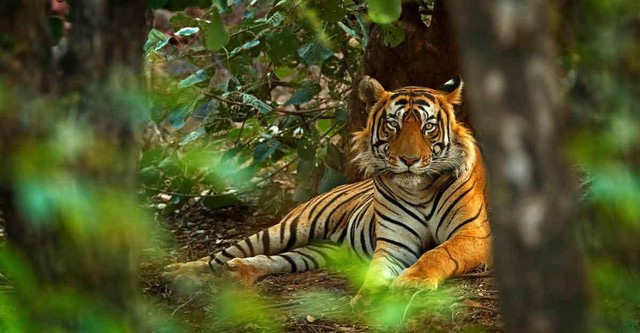Nothing is more dangerous than an aggressive tiger.
India is not only famous for its magnificent temples dedicated to Hindu and Islamic deities but is also home to some of the rarest wildlife on the planet. This country is a hotspot for biodiversity, featuring diverse ecosystems ranging from the Himalayas in the north to the evergreen rainforests in the south, sandy deserts in the west, and mangrove swamps in the east.
The three ecological regions in India include Western Ghats, Himalayas, and Indo-Burma, which host numerous endemic species not found anywhere else in the world. Statistics show that there are approximately 2,546 fish species in India (accounting for 11% of the world’s species), 197 amphibian species (4.4% of the world), over 408 reptile species (6% of the total reptile species globally), about 1,250 bird species (12% of the world), and around 410 mammal species (8.86% of the world). Among these, India has the largest number of cat species in the world.

Bengal Tiger.
This region is home to many world-famous cat species such as the Bengal tiger, Asiatic lion, snow leopard, and leopard, as well as smaller cats like the lynx, wildcat, and desert cat.
Currently, India boasts over 515 wildlife sanctuaries and 99 national parks spread across the country. The wildlife that has built India’s reputation includes the Bengal tiger, Asian elephant, crocodile, Indian rhinoceros, Asiatic lion, python, wolf, fox, and bear.
In fact, many scientists have ranked India as the second most dangerous destination for tourists wanting to see wildlife. This is because India is the only country in the world where visitors can simultaneously see tigers, bears, and lions in the same habitat.
However, among the notorious trio of predatory mammals here, the Bengal tiger is the most formidable and fearsome.

Bengal Tiger is an excellent climber and swimmer.
The Bengal tiger is a subspecies that primarily inhabits the Indian mainland and is considered the second largest tiger species in the world. Bengal tigers are renowned for hunting large animals such as Asian elephants and young rhinoceroses. Unlike many other tiger species worldwide, Bengal tigers are exceptional climbers and swimmers.
The hunting skills of tigers are also top-notch, as they typically stalk their prey, quietly approach, and swiftly deliver a fatal blow to take down their target, enjoying the spoils afterward.
Bengal tigers are dominant carnivores, persistently hunting by lying in wait until they see an opportunity when their prey is off guard. With their status, these tigers never have to submit to any creature; even in the video above, just seeing a man riding an elephant passing by is enough for them to perceive it as a threat and proactively attack first.
In this terrifying encounter, the tiger not only leaped out from the grass above the elephant but also knocked the man down with tremendous ferocity.


















































